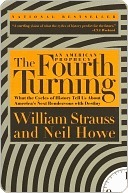More on this book
Community
Kindle Notes & Highlights
Read between
October 7 - October 15, 2022
That which hath been is now; and that which is to be hath already been; and God requireth that which is past. —Ecclesiastes 3.15
Where we once thought ourselves collectively strong, we now regard ourselves as individually entitled.
The reward of the historian is to locate patterns that recur over time and to discover the natural rhythms of social experience.
begin shortly after the new millennium, midway through the Oh-Oh decade. Around the year 2005, a sudden spark will catalyze a Crisis mood.
Sometime before the year 2025, America will pass through a great gate in history, commensurate with the American Revolution, Civil War, and twin emergencies of the Great Depression and World War II.
The rhythms of history do not reveal the outcome of the coming Crisis; all they suggest is the timing and dimension.
History’s howling storms can bring out the worst and best in a society.
“Time and his aging,” observed Aeschylus, “overtakes all things alike.”
the Enlightenment transmuted Christian linearism into a complementary secular faith, what historian Carl Becker called “the heavenly city of the eighteenth-century philosophers”—the belief in indefinite scientific, economic, and political improvement.
“Only the wicked walk in circles,” warned St. Augustine.
In America, as Mark Twain observed, nothing is older than our habit of calling everything new.
When we deem our social destiny entirely self-directed and our personal lives self-made, we lose any sense of participating in a collective myth larger than ourselves.
The linear school views all human history as akin to a ski jump: After crouching dumbly for millennia, mankind is just now taking off on its glorious final flight.
“Trends, like horses, are easier to ride in the direction they are already going,” writes Megatrends‘ John Naisbitt.


